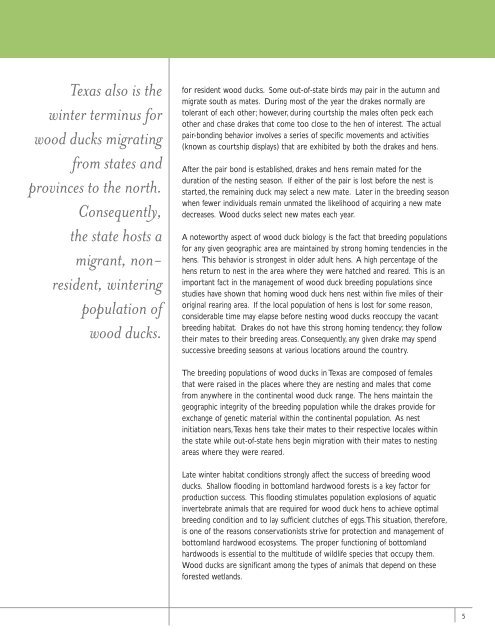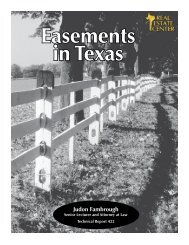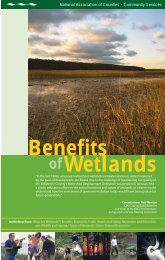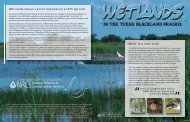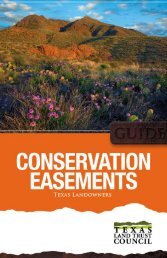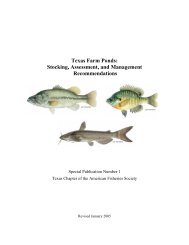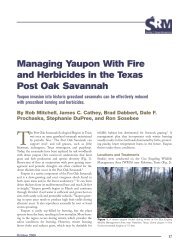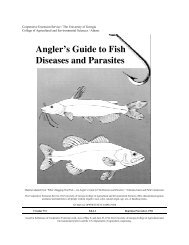Managing for Wood Ducks in East Texas - Trinity Waters
Managing for Wood Ducks in East Texas - Trinity Waters
Managing for Wood Ducks in East Texas - Trinity Waters
Create successful ePaper yourself
Turn your PDF publications into a flip-book with our unique Google optimized e-Paper software.
<strong>Texas</strong> also is the<br />
w<strong>in</strong>ter term<strong>in</strong>us <strong>for</strong><br />
wood ducks migrat<strong>in</strong>g<br />
from states and<br />
prov<strong>in</strong>ces to the north.<br />
Consequently,<br />
the state hosts a<br />
migrant, nonresident,<br />
w<strong>in</strong>ter<strong>in</strong>g<br />
population of<br />
wood ducks.<br />
<strong>for</strong> resident wood ducks. Some out-of-state birds may pair <strong>in</strong> the autumn and<br />
migrate south as mates. Dur<strong>in</strong>g most of the year the drakes normally are<br />
tolerant of each other; however, dur<strong>in</strong>g courtship the males often peck each<br />
other and chase drakes that come too close to the hen of <strong>in</strong>terest. The actual<br />
pair-bond<strong>in</strong>g behavior <strong>in</strong>volves a series of specific movements and activities<br />
(known as courtship displays) that are exhibited by both the drakes and hens.<br />
After the pair bond is established, drakes and hens rema<strong>in</strong> mated <strong>for</strong> the<br />
duration of the nest<strong>in</strong>g season. If either of the pair is lost be<strong>for</strong>e the nest is<br />
started, the rema<strong>in</strong><strong>in</strong>g duck may select a new mate. Later <strong>in</strong> the breed<strong>in</strong>g season<br />
when fewer <strong>in</strong>dividuals rema<strong>in</strong> unmated the likelihood of acquir<strong>in</strong>g a new mate<br />
decreases. <strong>Wood</strong> ducks select new mates each year.<br />
A noteworthy aspect of wood duck biology is the fact that breed<strong>in</strong>g populations<br />
<strong>for</strong> any given geographic area are ma<strong>in</strong>ta<strong>in</strong>ed by strong hom<strong>in</strong>g tendencies <strong>in</strong> the<br />
hens. This behavior is strongest <strong>in</strong> older adult hens. A high percentage of the<br />
hens return to nest <strong>in</strong> the area where they were hatched and reared. This is an<br />
important fact <strong>in</strong> the management of wood duck breed<strong>in</strong>g populations s<strong>in</strong>ce<br />
studies have shown that hom<strong>in</strong>g wood duck hens nest with<strong>in</strong> five miles of their<br />
orig<strong>in</strong>al rear<strong>in</strong>g area. If the local population of hens is lost <strong>for</strong> some reason,<br />
considerable time may elapse be<strong>for</strong>e nest<strong>in</strong>g wood ducks reoccupy the vacant<br />
breed<strong>in</strong>g habitat. Drakes do not have this strong hom<strong>in</strong>g tendency; they follow<br />
their mates to their breed<strong>in</strong>g areas. Consequently, any given drake may spend<br />
successive breed<strong>in</strong>g seasons at various locations around the country.<br />
The breed<strong>in</strong>g populations of wood ducks <strong>in</strong> <strong>Texas</strong> are composed of females<br />
that were raised <strong>in</strong> the places where they are nest<strong>in</strong>g and males that come<br />
from anywhere <strong>in</strong> the cont<strong>in</strong>ental wood duck range. The hens ma<strong>in</strong>ta<strong>in</strong> the<br />
geographic <strong>in</strong>tegrity of the breed<strong>in</strong>g population while the drakes provide <strong>for</strong><br />
exchange of genetic material with<strong>in</strong> the cont<strong>in</strong>ental population. As nest<br />
<strong>in</strong>itiation nears,<strong>Texas</strong> hens take their mates to their respective locales with<strong>in</strong><br />
the state while out-of-state hens beg<strong>in</strong> migration with their mates to nest<strong>in</strong>g<br />
areas where they were reared.<br />
Late w<strong>in</strong>ter habitat conditions strongly affect the success of breed<strong>in</strong>g wood<br />
ducks. Shallow flood<strong>in</strong>g <strong>in</strong> bottomland hardwood <strong>for</strong>ests is a key factor <strong>for</strong><br />
production success. This flood<strong>in</strong>g stimulates population explosions of aquatic<br />
<strong>in</strong>vertebrate animals that are required <strong>for</strong> wood duck hens to achieve optimal<br />
breed<strong>in</strong>g condition and to lay sufficient clutches of eggs.This situation, there<strong>for</strong>e,<br />
is one of the reasons conservationists strive <strong>for</strong> protection and management of<br />
bottomland hardwood ecosystems. The proper function<strong>in</strong>g of bottomland<br />
hardwoods is essential to the multitude of wildlife species that occupy them.<br />
<strong>Wood</strong> ducks are significant among the types of animals that depend on these<br />
<strong>for</strong>ested wetlands.<br />
5


